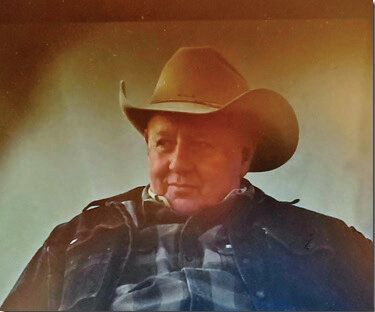
11 Jul Phil Epp
Settling and unsettling, the paintings of Phil Epp fill the canvas with a wide-open vastness. His perspective on the Western landscape rattles the framework of convention and yet perfectly portrays life on the plains. A slit of torrential downpour, visible from miles away. Animation-like clouds swim across the horizon. And a tumbleweed, like an alien spacecraft, hovers over the sagebrush, eerily surveying the topography.
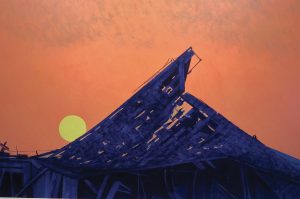
Collapsed Barn | Acrylic on Board | 30 x 40 inches
In 2016, the Newton, Kansas-based artist was inducted into the Cowboy Artists of America (CAA). “I related more to cowboy spaces rather than cowboy activity,” Epp says. “I portray the spaces that both mythical ideas and real life occupy.”
Through Epp’s work, the definition of Western art shifts. His paintings are not the typical ranch hands and branding; instead, they are an expansive way to view the landscape — by delving into the spaces that many people overlook.
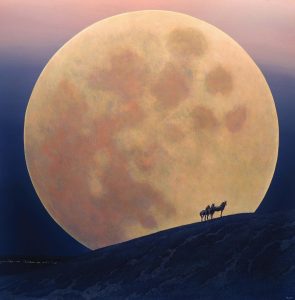
Moonrise #2 (Revised) | Acrylic on Board | 40 x 40 inches
“As life changes my perspective, I might see something old that seems very current to me now,” Epp says. “It happens in all kinds of ways. I look for icons that are of interest but haven’t been shared too much — like an old barn is an overdone icon, but a corner-post on a ranch, or maybe a tent, reach beyond those well-worn symbols.”
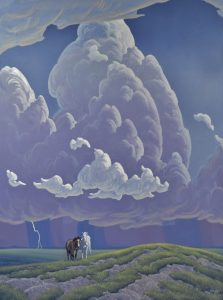
Gray Skies | Acrylic on Board | 40 x 30 inches
His tent paintings could very well become new icons. Tents are ubiquitous out West, but they are not often the subject of paintings. Epp uses the image to explore ideas of isolation and exploration while speaking with the voice of an outsider. “What I like about it is that it can be interpreted in so many different ways,” Epp says.
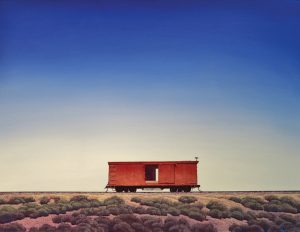
Lone Boxcar | Acrylic on Board | 30 x 40 inches
Another example, Lone Boxcar, depicts a single red boxcar against a clear morning sky. It evokes a sense of forgotten usefulness but also calls out to times past. For Epp, it brings back stories he heard growing up when a set of railroad tracks ran through his family’s pasture. “I remember [the homeless who] would come through and ask for food. In other parts of the world, boxcars have all kinds of history attached to them,” Epp says.
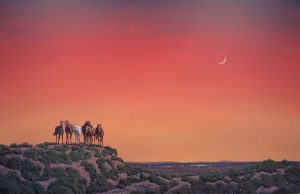
Scenic Overlook | Acrylic on Board | 30 x 40 inches
Recently, his paintings have included turbines, which rise from the land like futuristic crops. “I’ve painted the turbines for about 20 years; they’re such a visual assault on the landscape, but they can’t be avoided,” Epp says. “Turbines. I don’t like the way they look and what they’ve done to the landscape. I’m also disheartened that people see the West as a wasteland, as a place to be ‘filled in’ so they can do whatever they want to it. These turbine paintings are perfect for starting conversations about the way people view the West.”
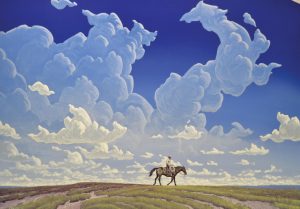
Lone Rider | Acrylic on Board | 30 x 40 inches
Shalee Cooper, the director and curator of Modern West Fine Art in Salt Lake City, Utah, has represented Epp’s work since the gallery first opened in 2014, and will host an exclusive online show for the artist from August 1 to September 30 on the gallery’s website.
“He’s so prolific, a true gentleman, and the salt of the earth, with a sensitivity to light and color,” Cooper says. “He has a very distinct voice. No matter what medium he uses, that sense of place comes through. And the most amazing thing about him is he’s still evolving.”
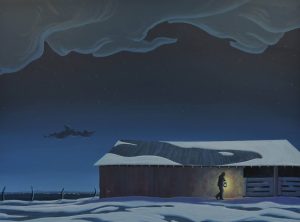
Night Lights | Acrylic on Board | 30 x 40 inches
For Cooper, Epp addresses his connection to the CAA through his understanding of the cowboy lifestyle. “He lives on the land, and his paintings are a reflection of the passion for the life he’s created,” she says. “It’s a contemporary take on the Western landscape. It’s interesting because it’s natural for people to want to categorize things, but his work doesn’t really fit into a single category.”
And there is poetry to Epp’s work: contrasting ideas that, when held up to the light, bring about illumination.
“His work is an honest documentation of his unique perspective,” Cooper says. “It’s loaded with a saturated palette that reflects life on a different kind of scale.”
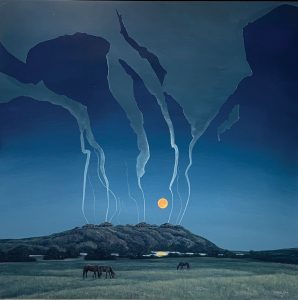
Pawnee Smoke | Acrylic on Board | 40 x 40 inches
When he was younger, Epp was interested in and influenced by the early Cowboy Artists. He also says he’s learned a lot from being a CAA member. “I do feel I’m a bit on the outside because I don’t have the realism skills they have […] a lot of them came from an illustrative or classical art background,” he says.
Epp also came from an art school background, but his inquisitiveness led him to landscape painting through the path of Abstract Expressionism. In the last five years, since a cancer diagnosis and treatment, Epp found urgency in his work, and his process changed. “I don’t want to add to the pile of stuff we see so much; I want to find my own voice,” he says. “I live in an area with open prairies, and I go out daily looking for something to paint. I do fewer paintings and a couple of commissions, but mostly I’m trying to find something new to say, to enter a world that I haven’t seen pictured before. And I’m working hard.”
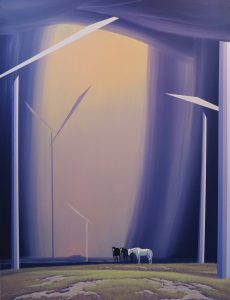
Turbine Field | Acrylic on Board | 40 x 30 inches
He’s currently working on a cloud painting. It’s almost a simulation of clouds moving across a crystal clear sky, chasing one another across the horizon. “It’s a bit different,” he says. “It started with a sketch I did 10 years ago.” He’s still not sure where it’s going or how it will end up, but that’s the challenge that drives him to the easel.
Artist Brandon Bailey, also a member of the CAA, is intrigued by the way Epp depicts the negative spaces within the Western landscape. He recently visited with Epp. “We went out to the Flint Hills in Kansas; it was neat to see the wild mustangs,” Bailey says. Seeing the horses roam freely struck Bailey as one of Epp’s paintings right in front of them. “The horses he paints are spot on; everything is where it should be, as it is with his figures. I think it’s great having him in the CAA because he brings such a fresh approach to the subject matter.”
For Bailey, it’s Epp’s ability to be expressive within the limits of representing the West. “What draws me to his work is his personal touch,” he says. “It accurately represents the West, and that’s important to him. It’s that authenticity that makes him a Cowboy Artist. For me, it’s almost edgy, very expressive, but the authenticity is right there.”






No Comments